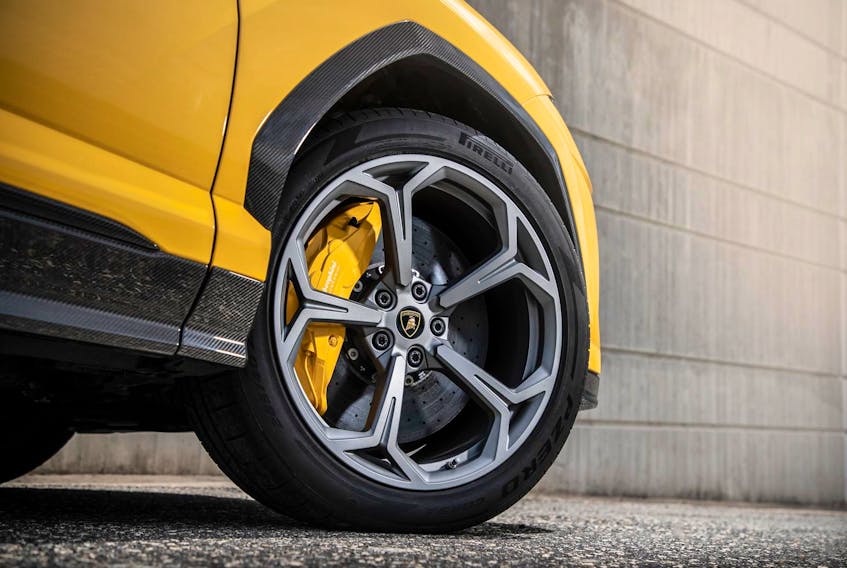TORONTO — They may look good, but big alloy wheels can be a big pain. Those chrome, 22-inch rims you love so much could make every pothole more jarring, every speed bump more intrusive and every minor road imperfection reverberate through the cabin like it’s a timpani drum.
This basic fact hasn’t stopped automakers from offering ever-larger hoops in an effort to make their cars look better.
What’s more, it’s working. Cars do look better with big wheels. Toyota’s new Rav4 Limited rolls on 19-inch rims. The 2001 Rav4 had 16s. Lamborghini’s new Urus SUV is, so they say, the first vehicle available from the factory with 23-inch alloys. They’re as big as flying saucers.
Since the late ’70s, rims have generally been trending larger on everything from compact hatchbacks to full-size luxury sedans and SUVs. It wasn’t always this way though.
The original 1959 Mini had dinky 10-inch wheels that look as if they’d been stolen off a go-kart. The brilliance of the Mini stemmed from the fact the mechanical bits — engine, wheels — were kept as small and as out-of-the-way as possible to allow more room for the parts that really mattered — people.

“Rims got small in the middle of the last century when a smooth low-rider was a hit on cruise nights,” said Ken Cummings, professor of transportation design at Humber College. “GM’s legendary design chief Harley Earl’s ‘lower, longer, wider’ dictum prevailed. People haven’t been into that look since DA haircuts and Buddy Holly hits.”
My own 1991 BMW 318is was supposed to be “sporty” but it only came with 14-inch alloys. It rides over potholes with cushy composure, as if suspended by fluffy clouds. Today, the entry-level BMW 330i xDrive comes with 18s. For an extra $500 you can have 19s. The ride of the new car is predictably harsher, at least when fitted with the M Sport suspension option as our test car was.
“Large, widely-spaced rims give the vehicle a better stance; they make the vehicle look more athletic and ‘ready to pounce,’” Cummings explained. “In the late 1970s, designers were drawing big rims on all their concept cars. Designers felt they looked sportier than whitewall tires and stamped wheel covers.”
Since cars themselves are getting bigger and bigger, wheels have had to grow just to maintain the same appealing proportions.
The pretty 19-, 20- and 21-inch alloy rims you regularly see on options lists have other drawbacks, beyond the added expense and negative impact on ride quality. For one, big wheels are easier to scrape against low curbs. For another, big wheels necessitate big wheel arches, which take up precious space that could otherwise be devoted to passengers.
Big alloys aren’t all bad though. They necessitate low-profile tires, which can make the steering feel sharper. Larger diameter wheels can also ride over road imperfections without getting deflected or swallowed whole by big potholes like smaller wheels might.

Some automakers — Mercedes-Benz and Maserati spring to mind — have become quite good at making their cars ride comfortably despite the big bling-y rims. In large part that’s thanks to new suspension technology like active dampers.
The battle over wheel sizes happens long before cars ever get to showrooms. “This is the discussion that takes place among designers, engineers and product planners — (they) try to come up with the best balance between the sporty appearance of large rims without compromising the ride and packaging efficiency of each vehicle,” said Cummings. Before becoming a professor, he worked in Chrysler’s design studio in Detroit.
Mazda designer Yasutake Tsuchida, the man responsible for the all-new Mazda3, sees no end in sight to the big-wheel trend. “You love big wheels, right? They look good!” he laughed. Indeed, the Mazda3 does look much better in GT-trim, rolling on 18s. The 16-inch hoops on the base model look like space-saver spares in comparison.
“I see some hope, now, to massively reduce wheel sizes again,” said Benoit Jacob, formerly of BMW, now VP of design at upstart electric automaker Byton. Looking to the future, he said transportation design and architecture could converge, with a new focus on the internal space rather than external look. “You can imagine that the best platform for shared mobility would have to have, from my perspective, extremely small wheels; you need a skateboard,” he said.
Ultimately, if you put a 10-inch rim on a new car today, it would look broken. Designers have little choice but to up-size rims.
However, you should think twice before ticking the option box for bigger alloys. Better yet, try to test drive any vehicle with different wheel options before you make a decision. Bigger isn’t always better.









